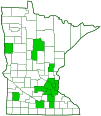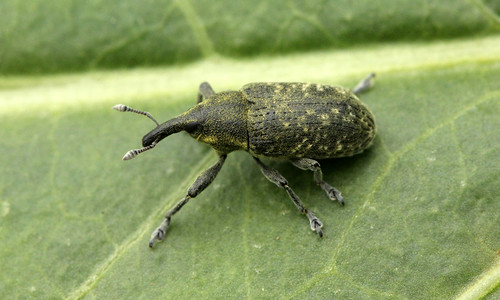Canada thistle bud weevil
(Larinus carlinae)
Conservation • Description • Habitat • Ecology • Distribution • Taxonomy
|
|
||||||||||||||
Description |
Canada thistle bud weevil is a common, exotic, small, true weevil. It is native to Europe and western Asia. It is believed to have been accidentally introduced into North America before 1968. It now occurs across most of southern Canada and the northern United States, but it is absent from the Great Plains. Canada thistle bud weevil was first reported in Maryland in 1971. Since it was already established in the United States, it was considered adventive, and no permit was required to redistribute it. It was intentionally redistributed as a biocontrol agent in several states in an attempt to control invasive Canada thistle. Unfortunately, it also attacks native thistles, including field thistle and swamp thistle. In Wisconsin, it has caused a moderate reduction in population growth of pasture thistle, and it is considered a serious pest of this already imperiled plant species. The larvae live in the flower heads of thistles and feed on the developing seeds. Adults are active from May to August wherever their host species are found. In the spring, they feed on tender developing leaves and shoots. Adults are 3⁄16″ to ⅜″ (5.0 to 9.5 mm) in length. The body is broadly oval, dark brown or black, and covered with short grayish hairs. Recently emerged adults are covered with yellow wax. The head is small, wider than long, and weakly convex. The surface is finely wrinkled. The mouthparts are greatly elongated into a snout-like projection of the head (rostrum). The rostrum is parallel sided when viewed from above, slightly curved when viewed from the side. It is longer on the female than on the male. The antennae are short and bent (elbowed), and they have 11 segments. They are attached to the sides of the rostrum beyond the middle. The first segment is very long, and it is gradually thickened toward the end. The last three segments are expanded, forming a compact, elongated-oval club. The plate covering the first segment of the thorax (pronotum) is oval, wider than long, broadest at the rear, and narrowed to the front. The sides are evenly convex. The surface is densely wrinkled. The rear margin is strongly convex on each side, forming a long, triangular, rearward-pointing extension in the middle. The plate between the wing bases (scutellum) is short and wide. The wing covers (elytra) are broadest behind the shoulders, parallel sided on the front half, weakly convex on the rear half, and broadly rounded at the tip. There are numerous scattered patches of grayish-white hairs, making the elytra appear pock marked. Each elytron has several narrow longitudinal grooves. The grooves are shallow, but they have a row of deep pits (punctate). The spaces between the grooves have crosswise wrinkles. The legs are entirely dark brown. The last part of each leg (tarsus), corresponding to the foot, has five segments, but the fourth segment is small and hidden between the lobes of the third segment, making the tarsus appear to have just four segments. There is a pair of claws at the end of each tarsus. |
Size |
Total length: 3⁄16″ to ⅜″ (5.0 to 9.5 mm) |
Similar Species |
Habitat |
|
Ecology |
Season |
One generation per year: May to August |
Behavior |
|
Life Cycle |
Overwintering adults become active in late May. After mating, the female seeks a flower bud between 3⁄16″ to ¼″ (5 to 7 mm) in diameter, chews a hole into it, inserts a single egg, and seals it with fecal matter. When the egg hatches, the larvae feeds, completes its development, and pupates while still in the bud. Adults of the new generation emerge in August and September. They overwinter on the ground in leaf litter. |
Larva Food |
Developing thistle seeds |
Adult Food |
Leaves and young shoots of the host plant |
Distribution |
||
|
Sources |
|
| 2/15/2024 | ||
Occurrence |
||
Common |
||
Taxonomy |
|
Order |
Coleoptera (Beetles) |
Suborder |
Polyphaga (Water, Rove, Scarab, Long-horned, Leaf, and Snout Beetles) |
Infraorder |
Cucujiformia |
Superfamily |
Curculionoidea (snout and bark beetles) |
Family |
Curculionidae (true weevils) |
Subfamily |
Lixinae |
Tribe |
Lixini |
Genus |
Larinus |
Aubgenus |
Phyllonomeus |
Until recently, this species was treated as Larinus planus, and Larinus carlinae was treated as a synonym. Following a review of the subfamily Lixinae (Gültekin, 2006), the species were separated. The name Larinus planus was applied to the well-known Eurasian species previously called Larinus rusticanus, and the name Larinus carlinae was applied to the well-known Eurasian species that was also introduced into North America. Since the name Larinus planus is still in use for another species, it is not treated as a synonym for Larinus carlinae. However, all historical references to Larinus planus in North America should be treated as Larinus carlinae. Not all sources have accepted the separation. Some sources continue to use the name Larinus planus and treat Larinus carlinae as a synonym. |
|
Subordinate Taxa |
|
|
|
Synonyms |
|
Hadroplantus planus |
|
Common Names |
|
Canada thistle bud weevil Canada thistle cylindrical weevil |
|
Glossary
Elytra
The hardened or leathery forewings of beetles used to protect the fragile hindwings, which are used for flying. Singular: elytron.
Pronotum
The exoskeletal plate on the upper side of the first segment of the thorax of an insect.
Punctate
Dotted with pits (punctures), translucent sunken glands, or colored spots of pigment.
Rostrum
The stiff, beak-like projection of the carapace or prolongation of the head of an insect, crustacean, or cetacean.
Scape
In plants: An erect, leafless stalk growing from the rootstock and supporting a flower or a flower cluster. In insects: The basal segment of the antenna.
Scutellum
The exoskeletal plate covering the rearward (posterior) part of the middle segment of the thorax in some insects. In Coleoptera, Hemiptera, and Homoptera, the dorsal, often triangular plate behind the pronotum and between the bases of the front wings. In Diptera, the exoskeletal plate between the abdomen and the thorax.
Tarsus
On insects, the last two to five subdivisions of the leg, attached to the tibia; the foot. On spiders, the last segment of the leg. Plural: tarsi.
Visitor Photos |
||
Share your photo of this insect. |
||
This button not working for you? |
||
Alfredo Colon |
||
 |
 |
|
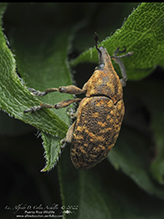 |
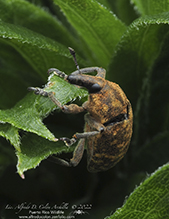 |
|
|
||
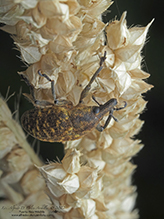 |
|
|
MinnesotaSeasons.com Photos |
||
|
||
|
||

Visitor Videos |
||
Share your video of this insect. |
||
This button not working for you? |
||
|
Other Videos |
||
Larinus carlinae couple (2) |
About
Sep 8, 2018 Couple de L. carlinae dans le chardon. Google Translate: Couple of L. carlinae in the thistle. |
Wollige distelsnuitkever Larinus planus, op akkerdistel (Woolly thistle weevil Larinus planus, on field thistle) |
About
Jul 4, 2020 11-vI-2020, Joppe, Leiden (Nederland. Wollige distelsnuitkever Larinus planus, op akkerdistel / on Cirsium arvense. Id. Theodoor Heijerman Insecta (Insecten, insects, Insekten, insectes), Coleoptera (kevers, beetles, Käfer, coléoptères), Curculionidae (snuitkevers, weevils, snout beetles, Rüsselkäfer, curculionidés) Google Translate: 11-vI-2020, Joppe, Leiden (Netherlands. Woolly thistle weevil Larinus planus, on field thistle / on Cirsium arvense. Id. Theodoor Heijerman Insecta (Insects, insects, Insects, insectes), Coleoptera (beetles, beetles, Käfer, coléoptères), Curculionidae (weevils, weevils, snout beetles, Rüsselkäfer, curculionidés) |

Visitor Sightings |
||
Report a sighting of this insect. |
||
This button not working for you? |
||
Alfredo Colon |
Location: Albany, NY |
 |
Alfredo Colon |
Location: Albany, NY |
 |
Alfredo Colon |
Location: Albany, NY |
 |
MinnesotaSeasons.com Sightings |
||
|

Created: 2/15/2024 Last Updated: © MinnesotaSeasons.com. All rights reserved. |
